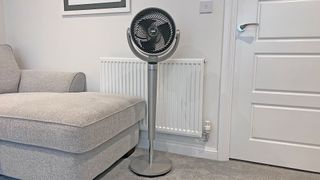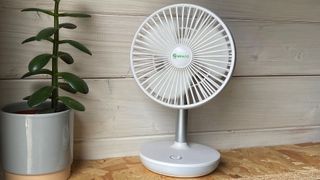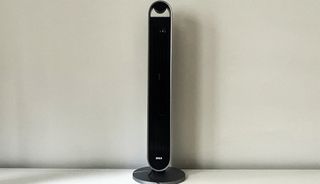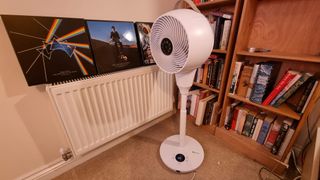
When the weather's hot, one of the best fans can be a lifesaver, especially if you don't have air conditioning. They're especially good at helping you sleep at night, as they basically double as a white noise machine.Unfortunately, once you've had one for a couple of weeks, you'll notice it's quickly built up an icky layer of dust, dirt, and grime. So although it's a bit of a pain, you will need to clean it.
In this guide, we'll explain exactly how to do that, whether you're trying to clean a pedestal or desktop fan, a tower fan or a ceiling fan. You'll need a few simple cleaning implements, like cloths and dish soap, and for some steps it's useful to bring in your vacuum cleaner's smaller attachments.
First, let's answer some key questions...
Do I need to clean my fan?
Yes. Cleaning your fan is important for a number of reasons. Firstly, a buildup of dirt on the blades will mean the fan has to work harder. That means it'll be less effective at cooling, may cost you more in electricity, and will probably not last as long.
Grubby blades also spread dust, allergens, and other microscopic particles into the air and into your lungs, which is unpleasant and can be damaging to your health, particularly if you suffer from allergies. Plus, of course, clean blades just look nicer.
How often should I clean my fan?
You should clean your fan at least once every three weeks during periods of use, and maybe more if you have a particular dusty environment, or are using your fan on a constant basis. In this guide, we'll explain the basics of how to clean a range of different fans.
That said, every device is different, so we'd urge you to read the manufacturer's instructions too, to check whether there are specific directives or advice for cleaning that particular model.
How to clean a desktop or pedestal fan
A pedestal fan is the kind that has a circular head that oscillates side to side, and can be tilted. They stand on the floor and are typically height-adjustable. A tabletop fan is essentially the same thing, but with a shorter stand, designed to sit on a surface. (An example is the MeacoFan 260c pictured below.) The cleaning process for the two is essentially the same – here's how to do it.

- Unplug the fan and ensure it's turned off.
- Remove the front grill if possible. Most desktop fans have a clip or screw system for easy disassembly.
- Use a soft, dry brush or microfibre cloth to gently remove dust from the blades. Be careful not to bend the blades.
- For stubborn dirt, dampen a cloth with a mild soap solution and wipe the blades carefully. Avoid getting water near the motor or electrical components.
- Clean the grill (both front and back if removable) with soapy water and a soft brush. This helps remove dust trapped in the grill's openings.
- Wipe down the base and other exterior surfaces with a damp cloth.
- Use compressed air or a small vacuum attachment to clean hard-to-reach areas, especially around the motor housing
- For the stand or neck of adjustable desktop fans, use a damp cloth to wipe away any accumulated dust or grime.
- Allow all parts to dry completely before reassembling. Once dry, reattach the grill securely.
- Use a cotton swab dipped in rubbing alcohol to clean the buttons or switches on the fan's control panel.
For deeper cleaning, you can disassemble the fan further and soak removable parts in soapy water, but be careful not to get the motor wet, and make sure you don't disassemble anything you're not going to be able to reassemble once you're done. The manual should include disassembly instructions so you can do this safely and effectively.
For fans with USB connectivity, be extra cautious around the USB port. Use a dry cotton swab to gently clean the port, ensuring no moisture enters.
How to clean a tower fan
A tower fan is a tall, slim fan that sits on a base. Our favorite one is the DREO Pilot Max (below). Dyson's fans are all tower models too, so if you're trying to figure out how to clean a Dyson fan, you want to follow the instructions below, although do consult your specific model's manual in case there are more specific instructions.
Get the best Black Friday deals direct to your inbox, plus news, reviews, and more.
Sign up to be the first to know about unmissable Black Friday deals on top tech, plus get all your favorite TechRadar content.
Here's how to clean a tower fan.

- Unplug the fan and turn it off.
- Vacuum the exterior grills and vents using your vacuum cleaner's brush attachment.
- Wipe down the exterior with a damp microfibre cloth.
- Use compressed air to blow dust out of the vents and interior.
- Wipe down the base and controls.
- For a deep clean, check if your model allows for opening the housing. If so, carefully open it following the manual's instructions.
- Clean the interior components with a damp cloth or compressed air. Be careful to avoid getting water near the electrical parts.
- Reassemble carefully, ensuring all parts are dry.
Note that some tower fans have removable filters that should be cleaned or replaced regularly according to manufacturer instructions.
How to clean a ceiling fan
A ceiling fan is not a plug-in fan. It's a permanent fixture, attached to your ceiling. Here's how to clean one...

- Turn off the fan and allow blades to stop completely.
- Place a drop cloth or old sheet on the floor underneath to catch falling dust and debris.
- Use a sturdy ladder to safely reach the fan, and move furniture out of the way. (It can be tempting to instead stand on furniture that's in easy reach. But please don't. It's not worth the hospital visit should something go wrong. Get a ladder.)
- Wipe the blades with a microfibre duster or cloth to remove loose dust.
- To remove deeper dirt, use a solution of warm water and mild dish soap. Dampen a cloth in the solution and wipe down each blade. Be careful not to get water in the motor housing.
- For stubborn grime, use an all-purpose cleaner. But try to avoid harsh chemicals in case it damages the appearance of the blades.
- Make sure you clean both the top and bottom of each blade. Just because you can't see the dirt doesn't mean it's not there!
- Wipe down the motor housing and any light fixtures, taking care not to damage them.
- Dry all surfaces thoroughly with a clean cloth.
- Let everything air dry completely before turning the fan back on.
If you have particularly high ceilings, you may need to use an extendable duster or cleaning pole to reach the blades safely from the ground. You could also try the pillowcase method: slip an old pillowcase over each blade and pull it off to capture dust.
How to clean other types of fan
Box fans: Remove the front grill and clean the blades with soapy water. Soak the grill in soapy water to remove built-up grime before cleaning, drying and re-assembling.
Window fans: Remove the fan from the window for thorough cleaning. Wipe the blades and grills, and vacuum out the housing before reassembling.
Bladeless fans: Use the brush attachment on a vacuum to clean the air intake. Wipe the loop amplifier with a damp microfibre cloth.
Car fans: Use a small brush to dust the vents, then wipe everyhere in reach with a damp cloth. Be careful to avoid getting water into the electrical components.
Fan cleaning tips

Whatever the type of fan you need to clean, bear these tips in mind.
- First and foremost, always ensure that fans are unplugged before beginning any cleaning process.
- When cleaning the blades, use a gentle touch to prevent bending them out of alignment, which could affect the fan's performance.
- If you have allergies or respiratory sensitivities, wearing a dust mask during the cleaning process can help protect you.
- When dealing with antique or particularly delicate fans, it's best to consult a professional for cleaning advice to avoid accidental damage.
- Thoroughly clean your fans before storing them away for the season.
- To keep your fans cleaner between cleanings, dust the blades weekly with a microfibre cloth; run air purifiers in rooms with fans to reduce airborne dust; keep windows closed on high pollen days if fans are running; and vacuum and dust your home regularly to minimize overall dust.
Tom May is a freelance writer and editor specialising in tech, design and sleep products. Over the years he's tested a number of mattresses, duvets and pillows, and as a back pain sufferer, has a keen interest in finding ones that offer maximum support. Plus, in running a successful Airbnb business, sleep hygiene and providing the right bedding for guests has become a big part of his day-to-day life. He is author of Great TED Talks: Creativity, published by Pavilion Books.
Most Popular


